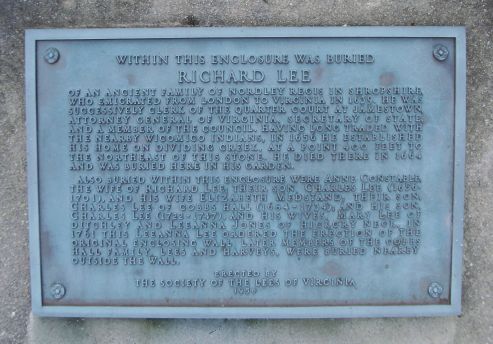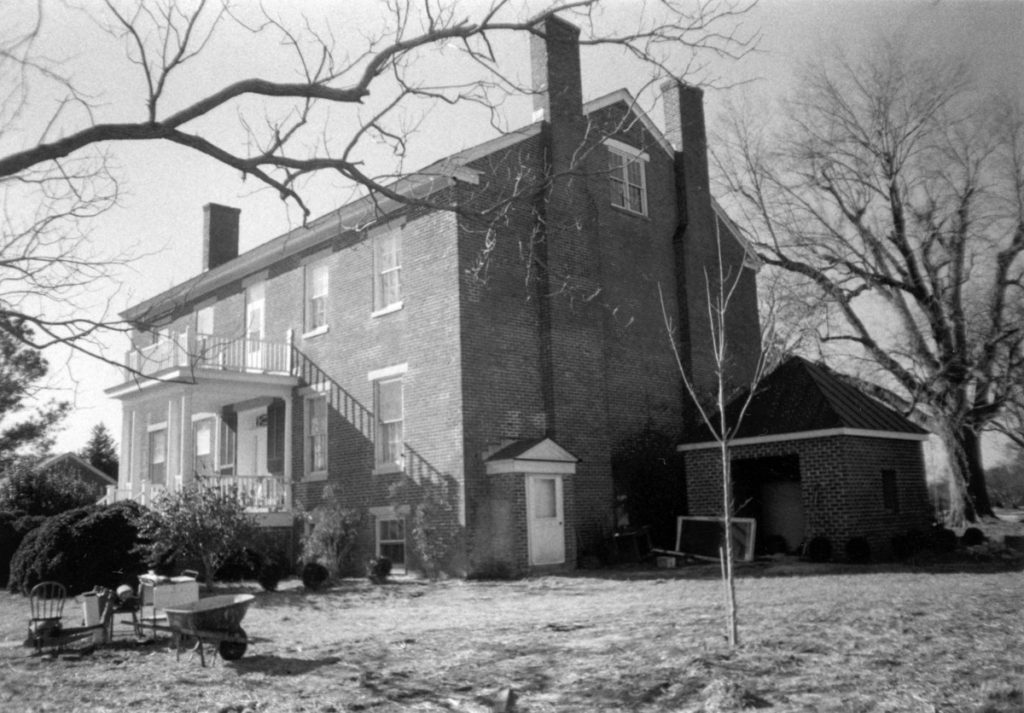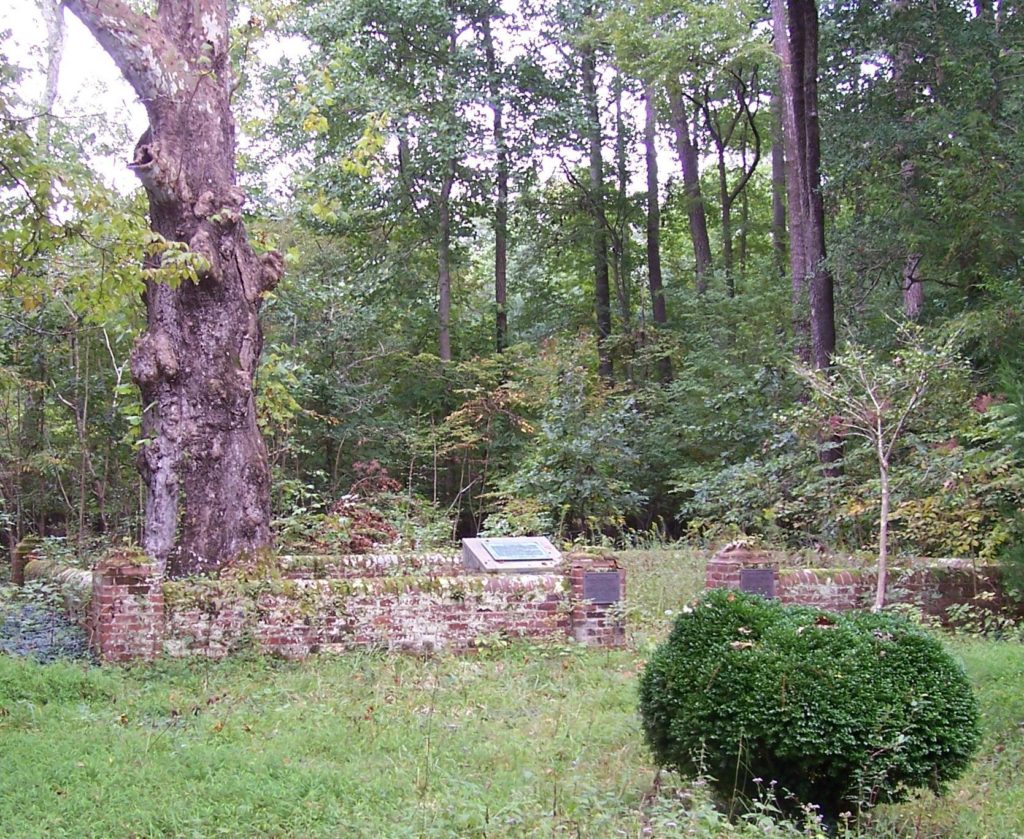The Floods Connection to the Virginia Lee FamilyFamily of Mary (Jones) Flood Richard Lee in Virginia Richard came to Virginia from Stratford Langdon in Essex, England in 1638 aboard the “Alexander.” He was the first Lee ancestor of Robert E. Lee in Virginia. He was the colonial Secretary of State in 1642. His first home was called “Paradise.” He was in the House of Burgess 1647 – 1651. Richard was born at Nordley Regis, Shropshire, England, which was a county bordering Wales. He emigrated from England in 1639, becoming Clerk of the Quarter Court at Jamestown, within the Secretary of State’s office. In the year 1640 Richard Lee married at Jamestown Anne Constable(c. 1621-1666) , daughter of Francis Constable and a ward of Sir John Thoroughgood, a personal attendant of Charles I, King of England (1600-1649). She had accompanied the family of Virginia Governor Sir Francis Wyatt (1575-1644), and at the time of her marriage to Richard, she was residing at the Wyatt household in Jamestown. This affiliation soon helped Richard move socially upward within the Colony. In 1643 the new Governor, Sir William Berkeley (1606-1677) appointed Richard Attorney General of the Colony. In addition he served as High Sheriff and was Colonel in the Militia. Anne (Constable) Lee (c. 1621-1666) Richard was in the fur trading business with the Indians. Because of this, Richard took his bride away from the capital city, and went to live among the Indians beyond the frontier of settlement. His first patent was for land on the north side of the York River at the head of Poropotank Creek, in what was then York, later Gloucester County. He had received the title to this 1,000 acre (4 km²) tract on August 10, 1642 through the headrights of thirty-eight immigrants unable to pay their own passage, who were brought over by Col. Lee in his own ship on his return from Breda in 1650. However, Lee did not take title to this land until 1646, when there is record of his purchasing 100 acres (0.4 km²) at this location. Richard’s first home was on leased land on the same side of the river, at the head of Tindall’s Creek near the Indian community of Capahosic Wicomico. However, on April 18, 1644, hordes of Powhatan Indians massacred the newcomers to the area, led by Chief Opchanacanough. They killed 300, but were driven back by a successful counterattack. As a result the English abandoned the north side of the river. Richard and his family escaped and settled at New Poquoson on the lower peninsula between the York River and the James River, where it was safer from attack. He was said to have been the first white man to have settled in the northern neck of Virginia. They resided upon this land for the next nine years, which consisted of 90 acres and was a comfortable ride from Jamestown. On August 20, 1646 he took out a patent for 1,250 acres (5 km²) on the Pamunkey River in York, later New Kent County, at the spot “where the foot Company met with the Boats when they went Pamunkey March under ye command of Capt. William Claiborne” during the counteroffensive against the Indians after the massacre of 1644. He did not develop these lands, but exchanged them in 1648 for a tract of the same land along the north side of the York near the present Capahosic, retaining the 400 acres (1.6 km²) he called “War Captain’s Neck” and selling the other 850 acres (3.4 km²). Colonial politics Lee became a Burgess of York County from 1647-1651, and in 1649 he was appointed a member of the King’s Council, and a Justice. In 1651 he became Colonial Secretary of State. With the title of Secretary of State, he was next in authority to the Governor, Sir William Berkeley (1606-1677). That same year, Charles I, King of England (1600-1649), was beheaded and Oliver Cromwell (1599-1658) began his control. Since the people in the distant colonies could not believe the incredible news from England, they remained loyal to the Crown and to Charles II (1630-1685), heir to the throne. In 1650, Richard made a voyage to the Netherlands to report Virginia’s loyal adherence to Charles II. However, this does not necessarily mean that he was a devout royalist. It turns out that two years later, he negotiated the capitulation of Virginia to the Commonwealth of England, and was satisfied with the terms that were laid out. At this time, he retired from public office, but continued to represent the interests of Virginia in London. Land holdings Richard began to acquire many land grants on the peninsula between the York and the Rappahannock River. After peace with the Indians had been concluded and the lands north of the York reopened for settlement in 1649, Richard was issued a patent of 500 acres (2 km²) on May 24, 1651, on land adjacent to “War Captain’s Neck”. That same year he also acquired an additional 500 acres (2 km²) on Poropotank Creek. He sold 150 acres (0.6 km²) of his original grant, the tract on Poropotank Creek. This left 850 acres (3.4 km²) at the original site, to which he later gave the name “Paradise”, and resided from 1653-1656 in the newly created Gloucester County. He became a part owner of a trading ship, whose cargoes brought indentured servants with headrights that Richard used to enlarge his Virginia property. He spent nearly as much of his time from 1652 to his death in 1664, in London, as he did in Virginia. In about 1656 Richard moved the family to Virginia’s Northern Neck, the peninsula formed by the Rappahannock and Potomac Rivers. Leaving the “Paradise” tract to overseers, they resettled on a spot acquired from the Wicomico Indians, which consisted of 1,900 acres (8 km²). This new land was termed “Dividing Creek”, near what is today the town of Kilmarnock. This tract in later generations became known as that of “Cobbs Hall”. Early colonial map of Maryland and Virginia (from Ogilby, 1671). The map is oriented with north on the right, reflecting its original purpose as a port-finding chart for ship captains approaching the entrance of the Chesapeake Bay. He later purchased another 2,600 acres (11 km²) in Northumberland County at Machodoc Creek, which empties into the Potomac River. This tract was patented on October 18, 1657, and repatented the following year on June 5, 1658 as 2,000 acres (8 km²). Upon this tract became what was known in later generations as the estates “Mount Pleasant” and “Lee Hall”. He then acquired 4,000 acres (16 km²) farther up the Potomac, near where the city of Washington, D.C., would rise, in what was then Westmoreland, now Fairfax County. One of these would eventually become the site of Mount Vernon. Disposing of several lesser properties he had obtained, Lee was able to consolidate and develop four major plantations. He had two in Gloucester County: “War Captain’s Neck” and “Paradise”, and two in Northumberland County: “Dividing Creek” and “Machodoc”. He also acquired a plantation called “Lee’s Purchase”, located across the Potomac in Maryland. In 1658 Richard acquired a residence at Stratford Langthorne, in the County of Essex, then a pleasant suburb of London, and in 1661 he moved his family there. Essex borders London on the east, and the village of Stratford Langthorne was a resort for persons of means who found London unhealthy. It is located about a mile from Stratford-at-Bow on the north side of the Thames in West Ham Parish, until recently the site of great wharves, docks, and the congestion of east London. He did that so that his younger children would have a proper education, seeing as his oldest two sons, John and Richard II, were already students at Oxford. Nevertheless, he eventually wanted his children to reside in Virginia. Though now a resident of England, he continued in his role as a Virginia planter and merchant. On March 1, 1664, Richard died at “Dividing Creek”, Northumberland Co., Virginia, while overseeing his interest in the Colony. As a result, and in accordance to his wishes in his will, his family returned to Virginia. Richard Lee’s will directed that his property at Stratford in England be sold, and that all but the two oldest sons, who were still finishing school, were to return to America. Richard I left property to each of his eight children. Anne married again before September 24, 1666, Edmund Lister. The date of her death is unknown, although legend has it that she was buried beside Richard near the house at Dividing Creek. Richard Lee died 24 April 1664 at Cobbs Hall, in Northumberland, Virginia. A picture of the plaque at the Cobbs Hall burial grounds is below. Today the different branches of the Lee family are known as: “Cobb’s Hall”, “Mount Pleasant”, “Ditchley”, “Lee Hall”, “Blenheim”, “Leesylvania”, “Dividing Creek”, and “Stratford”. These were the estate names of the descendants of Richard Lee I that are still referred to today when talking of Lee descendancy. An interesting note is that Richard had patented somewhere in the neighborhood of 15,000 acres (61 km²) on both sides of the Potomac, in Maryland and in Virginia. Part of this land later became George Washington’s Mount Vernon. When he divided his estate among his children, he also left them the products of the several plantations including white indentured servants, Negro slaves, livestock, household furnishings, silver, and many other luxuries. Notable descendants of Richard Lee I include signers of the Declaration of Independence Francis Lightfoot Lee and Richard Henry Lee, Revolutionary War general Henry “Light Horse Harry” Lee, Confederate Civil War generals Robert E. Lee, Richard Taylor, William Henry Fitzhugh Lee and George Washington Custis Lee, President of the United States Zachary Taylor, Chief Justice of the United States Edward Douglass White, Governor of Maryland Thomas Sim Lee. Children of Richard Lee and Anne Constable John Lee (1643-1673) of “Mount Pleasant”, who never married Cobbs Hall, the Home of Charles Lee, Sr., and Burial Grounds Ancestry of Richard Lee of Nordley, Shropshire, England Who Married Elizabeth Bendy Richard was the sixth of eight sons of Sir John Lee (1530-1605), of “Coton Hall”, Nordley Regis, Shropshire, England, and his wife, Joyce Romney (1528-1609). John and Joyce were married June 24, 1553. John’s will was dated May 7, 1605 and proved May 14 of the same year. He was buried June 13, 1605 at Chesham, Buckingham Co., England. Joyce was buried at Alveley on December 4, 1609. Besides “Coton Hall”, which was the manor house, there were several other farms included in the Nordley Regis lands, including “The Hay” which was the dower house, “Nordley Farm”, about a mile northeast of “Coton Hall”, and several others. It has been debated that the emigrant was a son of another of Sir John Lee’s eight sons. However, all of the other seven sons other than the oldest, Thomas Lee (d. 1621) who was the heir of “Coton Hall”, died without issue. Joyce was the daughter of John Romney, of “Hulsley”, Worcester Co., England. John was the son of Sir Humphrey Lee (1505-1588) of “Coton Hall”, and his wife, Katherine Blount (1506). Humphrey represented the “Coton Hall” Lees at the Visitation of 1569. He rebuilt “Coton Hall” on the medieval foundations. Katherine was the daughter of John Blount (ca. 1470) and his wife, Elizabeth Yee (ca. 1470). Humphrey was the son of Sir Thomas Lee II, Esq. (d. 1526), of “Coton Hall” and his wife Joanna Morton, daughter of Thomas Morton, of “Houghton”, Shropshire, England. Thomas resided at “Coton Hall” and “King’s Nordley” in Alveley Parish, Shropshire, England. Thomas was the son of John Lee V (1430), of “Coton Hall” and “Nordley” and his wife Elizabeth Corbin, daughter and heiress of Thomas Corbin. John V, was the son of John Lee IV (1398), of “Coton Hall” and his wife Jacosa “Joyce” Packington, daughter of Sir John Packington. John IV, was the son of Robert de Lee, High Sheriff of Shropshire (ca. 1343-1419) and Margaret de Astley (ca. 1347). Robert and Margaret married in 1385, and resided at “Roden” and “Stanton”. Robert was the first Lee of “Coton Hall”, at Nordley Regis. Margaret was the daughter of Thomas Astley, 3rd Lord Astley, of “Nordley Regis” and “Coton” (ca. 1317) and his wife Elizabeth. Robert was the son of John de la Lee III, of “Roden” and Stanton” (ca. 1317) and his first wife Alicia. John was granted the Manor of “Stanton”. He also resided at “Beriton”. John III, was the son of Sir John de la Lee II, of “Roden” and “Stanton” (1291) and Matilda de Erdington (ca. 1295), daughter of Henry de Erdington II, of “Roden” (ca. 1275) and Joan de Wolvey. John II, was still living in 1327. John II, was the son of Reginald de la Lee II, of “Langley” (ca. 1265). Reginald II, was the son of Sir Thomas de la Lee I (ca. 1239) and Petronilla Corbet (ca. 1233). Petronilla was the daughter of Sir Thomas Corbet, Baron of “Caus” (ca. 1209-1274) and his second wife, Isabel de Valletort (ca. 1209). Thomas was Sheriff of Shropshire. Thomas I, was the son of John de la Lee I (ca. 1209). John I, was the son of Reginald de la Lee I, High Sheriff of Shropshire “Reiner de Lega”. Reginald I, was in turn the son of Hugo “Hugh” de Lega, who came with William “the Conqueror”. Richard Lee claimed the right to the Coat of Arms of the Lee of Shropshire, England, before the Court of Admiralty in London. According to this view, Richard was purportedly a son of Richard Lee, Gent, and his wife, Elizabeth Bendy. This elder Richard was baptized October 6, 1563 at Alveley Parish, Shropshire and he married Elizabeth on October 21, 1599 at Alveley Church. Richard was alive as late as October 21, 1621, when he received 15 pounds in the will of his brother, Capt. Gilbert Lee (d. 1621), of “Tolleshunt Darcy”, Essex, England. He was the sixth of eight sons of Sir John Lee (1530-1605), of “Coton Hall”, Shropshire, and his wife, Joyce Romney (1528-1609). In 1988, William Thorndale (National Genealogical Society Quarterly, 76-4, pp 253-267) claimed that Richard Lee was actually the son of a John Lee (sometimes Lees or Leys) (1590-1629/30), a member of the Clothiers’ Company (i.e., manufacturers of woolen cloth) and Jane Hancock. This Richard was christened 22 March 1617/8 at St. Martins Parish in the city of Worcester.. Subsequently, Thomas Woodcock, Somerset Herald at the College of Arms, was engaged by David Halle (Genealogist of the Society of the Lees of Virginia at the time) to try to find further confirmation of this deduction. Although failing in this, Mr. Woodcock did develop the strong probability that this John Lee (1590-1629/30) was the son of an earlier John Lees (ca.1566-1597), weaver, of Worcester. Mr. Thorndale generously supplied evidence to establish this parentage with certainty, and Dr. Neil Thompson then further confirmed it. Genealogist Alan Nicholls’s research into Richard’s ancestry re-asserts the traditional Shropshire ancestry that he claimed his whole life, and which was verified by a member of the college of arms during his lifetime. |





